|
|
|
 |
|
"WHEN
THE LORD BROUGHT BACK THOSE THAT RETURNED TO ZION,
WE WERE LIKE THOSE WHO DREAM"
PSALM 126:1
|
|
| |
|
 |
|
July 26, 1983 |
|
|
| Dominating the
Samarian hills, Sebaste was a superb location for a
summer retreat. Two thousand years ago, King
Herod the Great had named the city after his patron
the Roman Emperor Augustus. Only 30 some miles
from Herod's seaside palace at Caesarea, Sebaste at
1400 feet above sea level caught the refreshing
breeze wafting eastwards from the Mediterranean. |
|
|
|
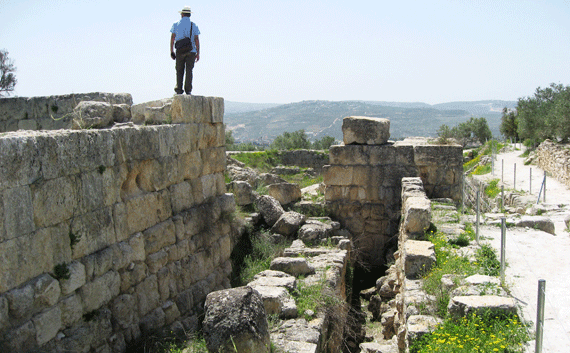 |
|
Photo: Gila
Yudkin |
|
Sebaste's lookout over the hills
of Samaria |
|
|
|
This is the place where Herod married Mariamne, the
beautiful, strong-willed heiress to the high priest
temple aristocracy. Herod, consumed by ambition to
rule over the kingdom of Judea, had realized very
early on, that if you can't be blue blood royalty
yourself, then the next best thing was to marry into
it. |
| |
Earlier,
by nearly nine centuries, another
high-profile couple tied the knot on this very hilltop.
Ahab, heir to the throne of Israel, married
Jezebel, the Phoenician princess from Sidon. I
imagine that wedding to be a mega-event with
platters of roasted lamb garnished with garlic, beef
burgers from the cows of Bashan, fava bean
vinaigrette, honey-coated fig cakes and pomegranate
liqueur, a Samarian specialty, served to the guests.
Ahab's dad Omri king of Israel had chosen this hill
for his palace, paying two
talents of silver for the property. He named it Shomron
(Samaria in English) after its former owner.
Omri had cemented his alliance with the wealthy,
sea-faring, pagan Phoenicians with this marriage
between Ahab and Jezebel. The Phoenicians more
than likely supplied him with cedar wood for the
royal residence and perhaps ivories as well to
decorate the furniture. |
|
|
|
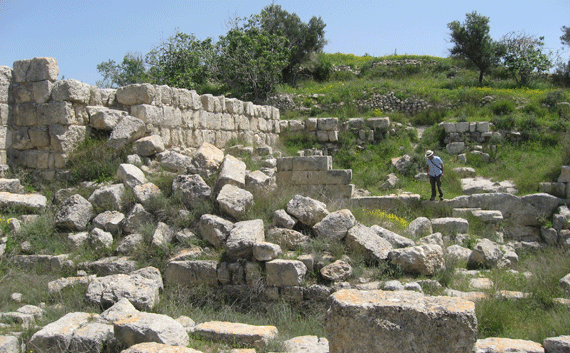 |
|
Photo: Gila
Yudkin |
|
Ruins at Sebaste/Samaria -- some
of Ahab's White House |
|
|
During the honeymoon, Ahab discovered that he had
married a head-strong, cunning and ruthless woman
who quickly became his closest advisor. When
Ahab's neighbor Naboth refused to sell him a choice
vineyard plot which produced the most tweeted-about Chardonnay
for miles around, Jezebel solved this thorny
problem. She conspired to accuse Naboth of
blasphemy, bribed witnesses to deliver false
testimony and Naboth was subsequently eliminated by
being stoned to death.
Jezebel of course had not taken into account that "troubler
of Israel" Elijah of Tishbi. Sure enough,
Elijah appeared, wearing his signature London Fog
trench coat (actually it was probably a full-length
woolen cloak with a leather belt) to accuse Ahab,
"Have you murdered and also taken possession?
Thus says the Lord, 'In the place where dogs licked
the blood of Naboth, dogs shall lick your blood,
yes, yours'."
And there's more gore to come:
After Ahab was wounded while fighting the Arameans
(modern-day Syrians) and bled to death, his chariot
driver brought Ahab's body back to Samaria for burial.
The chariot was washed in the pool of Samaria and
the dogs licked his blood while the harlots bathed,
just as Elijah had foretold. |
|
|
|
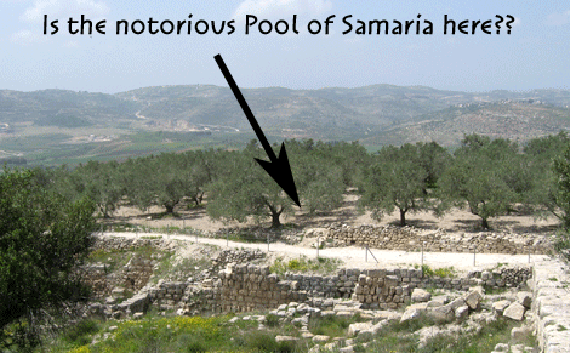 |
|
Photo: Gila
Yudkin |
|
Where is the notorious Pool of
Samaria? |
|
|
A Connecticut Yankee by
birth, I must have imbibed that Puritan perspective
where black is black and white is white with no
in-between. I adore spaghetti westerns where
the "bad guys" get their just reward. Elijah
is my hero. A tall skinny guy (after all, he
was fed by ravens) with long hair, blazing eyes and
ears perked to sounds of silence.
The students always liked my Elijah stories -- I
could tell by their rapt attention. And I
had no reason to suspect that today, July 26 would be
any different.
I was guiding a group of college kids from the East
Coast, mostly New York and New Jersey. They
had come for a summer program sponsored by the
Jewish Agency, the same type of tour I had joined
when I was a teen. Our red Egged bus was full
of chattering joyful students. This was before
the days when nearly all kids tour with earphones
blasting their favorite rock/rap/hip-hop music and
they seem impervious to the outside world.
These kids actually related to one another. |
|
|
We arrived at Sebaste from the Galilee via the
Jezreel Valley and Jenin. Afterwards we were
planning to travel south along the patriarchal
highway, the watershed route, in the footsteps of
Abraham and Jacob to Shechem and then on to Bethel
with a possible detour to Shiloh and then "up" to
Jerusalem with our first look over the holy city
from the Mount of Olives.
I loved the challenge of finding the hidden turn-off
to Sebaste, driving up the narrow road framed by the
Arab village of Sebastiya down to our right and the
terraced fruit orchards of figs, almonds, olives and
pomegranates up the hill to our left. We drove
along an impressive row of hundreds of columns still
upright from the Roman period.
|
|
|
|
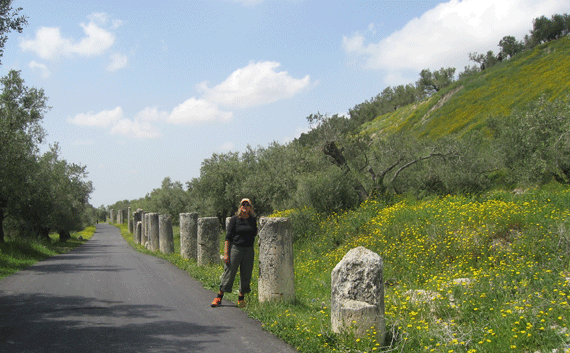 |
|
Photo: Gila
Yudkin |
|
Gila walking along the Roman
Street in April 2014 |
|
|
|
We parked in the huge parking lot, once a Roman
Forum. There was a small kiosk to our right. Ten
years later Mussa, a local villager just returned
from studies in the States, would convert it to a
trendy Middle Eastern eatery with the best tabouleh salad I have ever tasted. |
|
|
|
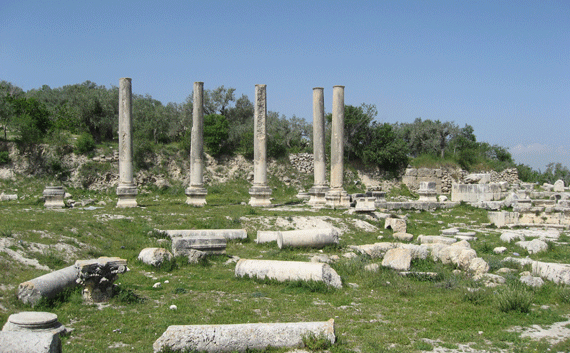 |
|
Photo: Gila
Yudkin |
|
Ruins of the Roman Forum near the
parking lot of Sebaste |
|
|
|
 |
|
Photo: Gila
Yudkin |
|
Mussa's restaurant has the red roof;
the parking lot is to the right |
|
|
In those days we had no plastic mineral water bottles to
litter the landscape, so we all filled our canteens from
Styrofoam jerry cans on the bus. Then we tramped
up the steep trail towards the west with yours truly
leading the way to the top of the
Roman theater. We peered down onto the rows of
seats for the audience and then way down below in the
valley we saw the Roman hippodrome.
I told the kids that Roman passions ran high when it
came to chariot-racing, the most popular form of public
entertainment in the Roman Empire. Frequently
revolts broke out in the hippodrome (just like riots at
European soccer matches today). The charioteer
drove standing upright in his chariot, wearing a light
helmet and a belted tunic in his team's color -- white,
green, red or blue. Eventually these colors came
to be identified with specific political parties.
Roman chariots were built as light as possible, purely
for speed and were drawn by two or four horses.
The larger the teams of horses, the more expert the
driver needed to be. The public adored the fastest
drivers -- they were comparable to our modern day
million-dollar Super Bowl athletes. Before I finished, one of the
spunky guys in our group stood up, clenched his fists
showing muscular biceps and imitated a chariot driver to
shouts of "Ben Hur" from the group.
(Remember this was before "Gladiator" made Charleton
Heston look like a wimp.) |
|
|
|
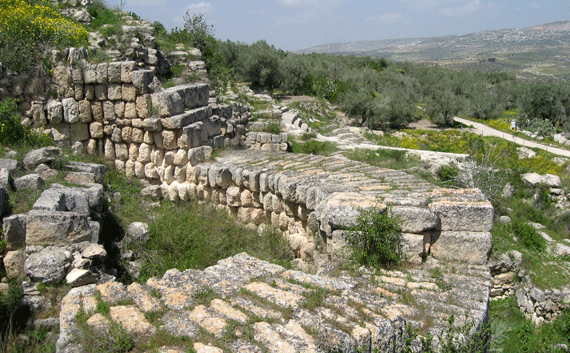 |
|
Photo: Gila
Yudkin |
|
Ruins of the Roman theater at Sebaste |
|
|
|
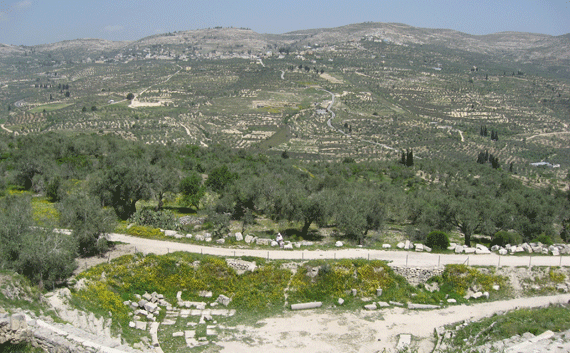 |
|
Photo: Gila
Yudkin |
|
Looking down towards the valley,
location of the hippodrome or horse course |
|
|
|
We continued west on the trail through the terraced
orchards until we saw the well-preserved steps of
Herod's Temple to Augustus. We climbed, just east
of these steps, to a high point, for a 360 degree view.
On winter tours after a heavy rain had cleared the dust,
I would point out the Mediterranean and Caesarea marked
by its modern power plant towers. But in the July
haze, we had to rely upon my descriptive abilities and
our imaginations. |
|
|
|
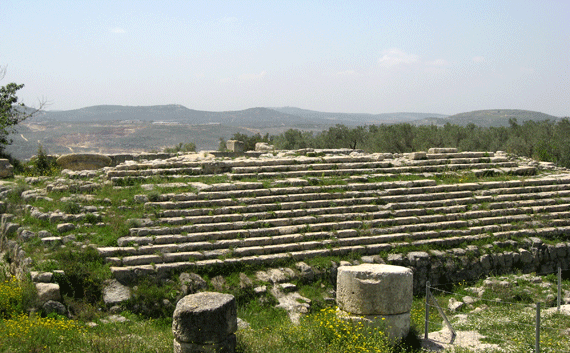 |
|
Photo: Gila
Yudkin |
|
The Augusteum or temple
dedicated to Augustus may have been 75 feet
high |
|
|
| |
Then we descended from the high point at the
acropolis to the ruins of Ahab's White
House. I'm not kidding -- the Bible
dubs it the Ivory House. The First
Book of Kings tells us, "The rest of the
history of Ahab, his entire career, the
Ivory House he erected…is not all this
recorded in the Book of Annals of the Kings
of Israel?"
But Israel's prophets, especially Amos,
railed against the conspicuous consumption
of the Israelite royalty personified as
lying on beds of ivory. As an aside to
the kids, I remarked, "As if they were lying
on waterbeds while carrying on business of
state!"
Amos decreed that the people who lie upon beds
of ivory shall be brought down. The
ivories, imports from pagan Phoenicia,
symbolized the decadence of the northern
kings who lounged on ivory couches while
ignoring injustices to the poor.
In the 1930s, an expedition from Harvard
University found hundreds of fragments of
ivories which once decorated palace walls
and furniture. These ivories, many of
them found with Hebrew letters on them,
demonstrate the wealth of the northern
kingdom of Israel and indicate the influence
of foreign cultures upon the Israelite upper
classes.
|
|
|
| As I was
going on
about the ivories, I look around the group
to see if I still have their attention.
Hmm, I think. Time to stick in the
joker which is Agatha Christie. Her
husband Max Mallowan was an archeologist
digging out the king's palace in Nimrod,
Assyria which is northern Iraq of today.
Agatha loved jigsaw puzzles and as she sat
at excavation headquarters cleaning the
ivories, she tried to figure out which
broken pieces went together.
At the
same time, Max's workmen on the site were
surreptitiously pocketing other ivories,
many of which later ended up at the British
Museum in London or the Bible Lands Museum
in Jerusalem. Some of the ivories Agatha Christie was piecing together may even have
been looted from this very palace, as well
as other palaces conquered by the Assyrians
in Damascus and Phoenicia.
Now as we sit in the ruins of the White
House, I retell the story of Ahab, Jezebel
and Elijah. We imagine the prostitutes
splashing in the pinkish bloody waters of
the Pool of Samaria. I contrast the
death of Ahab, fatally wounded while in
disguise in his war chariot, with the ascent
of Elijah in a chariot accompanied by fire
and a whirlwind. We talk about power
and authority: king versus prophet. We
consider, "Do evil people inevitably 'pay'
for their sins? Is there such a thing
as divine justice?" |
|
|
| Then we move
on to Herod. Like Ahab, Herod "the Great"
was an energetic and zealous builder.
He raised Samaria from its ruins and renamed
it Sebaste, meaning venerable, which was the
Greek name of Augustus his patron.
Herod's Sebaste enclosed an area of 160
acres with the temple to Augustus at its
acropolis. |
|
|
|
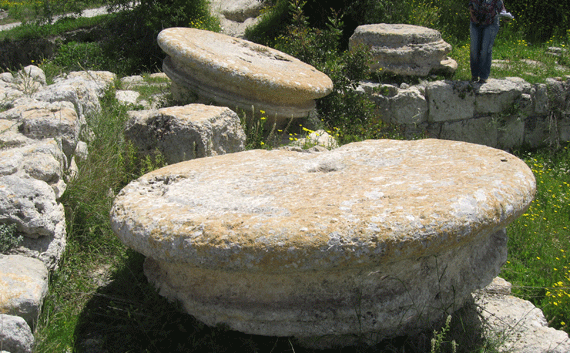 |
|
Photo: Gila
Yudkin |
|
This base probably stood
in Herod's temple dedicated to Augustus |
|
|
But Herod's palace was haunted. After
rescuing Mariamne from Masada where she and
her family and Herod's family had taken
refuge, Herod married the proud princess at
Sebaste. This event may have been a
catered affair with shish kebab, baby
chickens doused in spicy almond sauce,
cinnamon pears, exquisitely stuffed dates,
Roman nut cakes and imported Cypriot wine.
Twelve years later, in a jealous rage, Herod
had Mariamne slain. He accused her of
infidelity and trying to bribe his
cup-bearer to poison him. But this was
not the end of Herod's marriage
difficulties. |
|
|
Once she was dead, the king's affections
were kindled for her in a more outrageous
manner than before, according to Herod's
historian, Josephus Flavius. At night
he would desperately roam from room to room,
madly calling out her name. Later, it
was right here at Sebaste that Herod ordered that their
two sons be strangled. It was said
about Herod that he loved his relatives best
when they were dead!
But the rabbis had something else to say.
There is a Talmudic legend that out of love
for Mariamne, Herod had her corpse preserved
in honey for seven years. |
| |
|
I didn't always tell the story of the honey.
It depended on the sophistication and
Puritanism of the group. I'm not sure
that I told it to this particular group, but
I am certain that I told it to myself.
|
|
|
| Just as we
approached our last major ruin, a fifth
century Byzantine church, I stopped short to
face the kids. |
|
|
|
Now it was time to switch historical gears.
Here at Sebaste, I told them, added to the spooky legends
of a bloody royal chariot, a honey-embalmed
queen, a monarch stark crazy, we have the
burial shrine of none other than John the
Baptist. Not his body, nor his soul,
but his severed head.
The beheading happened at a royal
celebration. This time it was a
birthday party for Herod's son, also called
Herod. My Jewish group was not all
that familiar with the Gospel account of the
strip-tease dance of the seven veils and
Herod's step-daughter's demand for John the
Baptist's head on a platter. So I
summarized the story. |
| |
|
Though John was clearly executed in the
Herodion palace in Machaerus above the
eastern shore of the Dead Sea, the tradition
of burial of John's head was venerated here
by fifth century Christian pilgrims. It may
have happened because early Christian
writers confused King Herod who built Sebaste with his son, also called Herod who
was king of Galilee and Perea (modern-day
Jordan). Or it could have been the
guides who invented this tradition. Perhaps
there were souvenir stalls selling remnants
of the silver platter or torn relics of the
veils along the sight-seeing route. |
|
|
|
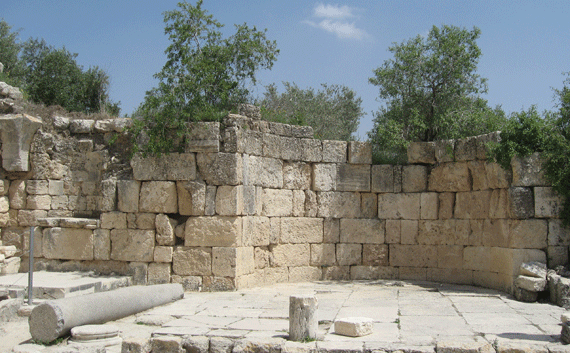 |
|
Photo: Gila
Yudkin |
|
Ruin of Church of John the
Baptist at Sebaste |
| |
In any case, in the fifth century a small
church was erected here as a shrine to
venerate the burial of the head of John the
Baptist. There is a cathedral down in
the village of Sebastiya which supposedly
marks the burial of his body. Anything
to attract pilgrims to two different venues…
Thus ended our tour and as usual, I had to
ask a few of the trouble-makers to jump down
from the precarious ruins they had climbed,
hoping neither student nor ruin would be
injured. |
| |
|
Despite its sinister and bloody history, our
mood at Sebaste was pastoral and peaceful.
The group was fun and receptive. Most
of the students were not familiar with Ahab
and Jezebel, but they were all conversant
with good and evil and our discussion of the
question of divine justice was vigorous.
I was looking forward to our next site, the
old city of Shechem, where I would tell the
story of the rape of Dinah, Jacob's daughter
and the tricky deceit by Jacob's sons.
That's one story I didn't learn in Sunday
School and I'll bet that they didn't either. |
|
|
|
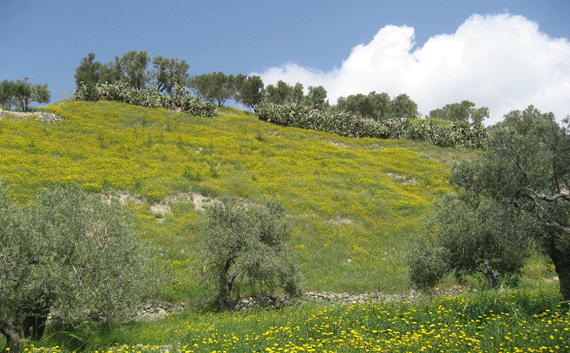 |
|
Photo:
Gila Yudkin |
|
Peaceful pastoral view of
Sebaste/Samaria |
| |
|
When we returned to the bus, it was late
morning. The driver was anxiously
pacing outside the bus. He told me he had just
heard the first radio reports of a
mysterious shooting attack at the Islamic
College campus in Hebron. Some
unidentified assailants had sprayed bullets
into the Islamic College and for added
effect, tossed a grenade. Three
students were dead and no one yet knew how
many students and faculty members were wounded.
It was speculated that this may have been
retribution for the murder of a Jewish
yeshiva student a few weeks earlier in the
casbah, or crowded marketplace of Hebron. |
|
|
|
Hebron? I thought. I had never visited
the Islamic College in Hebron, but the Tomb
of the Patriarchs I knew well. The
same Herod who built up Sebaste enclosed
what is probably the authentic burial site
of the Patriarchs with an impressive
edifice, eerily similar to the enclosure
encompassing the Temple Mount in Jerusalem. |
| |
|
 |
|
Photo:
Gila Yudkin |
|
Herodion enclosure over
the Tomb of the Patriarchs in Hebron |
|
|
|
In those early days I loved visiting
Hebron's Cave of the Machpelah, the Tomb of
the Patriarchs. Most memorable was the
Mosque of Isaac and Rebecca with its caged
five-foot high tomb monuments decorated with
lime-green, peacock-blue and faded
shocking-pink scarves and embroidered
bedspreads. Next door was an
improvised synagogue with large
crème-colored ostrich eggs hanging on chains
swinging over the tomb monuments of Abraham
and Sarah. |
| |
|
But Hebron was 67 miles to the south, what
did this have to do with us? Why was
the driver so nervous? Then it hit me. Riots and rock-throwing. The driver
interrupted my reverie by saying, "The
question is how soon." Hmmm. We
were stuck, in the middle of the "Wild West
Bank" with the near-certain prospect of
riots in all major towns and villages around
us. The rioters would be the
Palestinian shabab (young men like
gangs), the same age as my college students.
|
|
|
| So now we
had to decide, were the demonstrations
spontaneous, or were they organized by the
outlawed PLO? |
|
|
|
Avi, our driver, had fought in some mean
battles in Sinai in 1973 and I trusted him
implicitly. I looked at him intently
as we spoke softly in Hebrew outside the bus
as the kids boarded. He was shorter
than me, a mesomorph with a strong body and
bulging muscles. He had a large mole
on his right cheek. Avi thought the
demonstrations were spontaneous and would
start immediately. I didn't think so –
I thought they needed time to organize.
That would mean that we had time, also. But
not too much. |
|
|
| With a jolt,
I realized that the decision of what to do
was mine. I felt in my guts that the
demonstrations appeared to be "spontaneous"
but there was a guiding hand behind them and
I reckoned that an hour was needed for
organization before the "spontaneous" riots
broke out. I decided we would make a
run for it. It's not like we had much
choice. Waiting at Sebaste with our
heads down could be a disaster if the riots
were prolonged. We didn't have cell
phones in those days to call for help or
advice. |
|
|
|
Avi was cool, calm and collected. I
think I looked that way, or at least I hoped
I did. But my heart was thumping somewhere
near my vocal cords. Avi took his
heavy 9mm black pistol out of his knapsack,
checked he had bullets and loaded the
magazine. The safety was on. He
laid it in his lap. I sat next to him
in the guide jump seat. I held the
microphone, ready to tell the kids to bend
over, cover their heads with their arms and
put their faces between their legs if I saw
any masked youths hurling stones at our bus.
I hoped there would be no Molotov cocktails. |
|
|
|
We didn't backtrack. I decided that we
would race non-stop to Shechem/Nablus and
then instead of driving through the old town
and past Jacob's Well, to turn east to descend
into the Jordan Rift Valley.
And just like that, 35
minutes later, we had sped past the flash
points of danger.
An hour later we heard on the Hebrew news
that riots had just broken out in Nablus and
there were already a number of dead and
injured.
In those days there were no distractions or
breaking news from smart phones or tablets,
so the kids on my bus were clueless.
I, however, returned home from my tour of Sebaste
totally spooked. |
|
|
|
There were other dangers I subsequently
encountered as a Holy Land guide. Once
we had to flee with Yankele at the wheel of
his 30-seater safari truck when the
Wilderness of the Temptation turned into an
Israeli tank firing zone. In the late
nineteen eighties down in Jerusalem's Kidron Valley
by Hezekiah's Tunnel, we were threatened by
a Palestinian mob and I had to call the army
to come rescue us. (There were no injuries
and we emerged safely.)
|
|
|
|
But this episode at Sebaste was the first
dangerous dilemma I faced as a guide.
I guess it's what you call "on the job
training". Nothing I had learned in
the guide course had prepared me for this.
|
|
|
|
This is one chapter in Gila's work in
progress, "Holy Land Haunts: Forty
Years of Guiding Adventures." |
|
|
Read what Tour
Leaders say about Gila.
|
|
|
Tour the Temple
Mount
in the company of Abraham and Isaac, David
and Solomon, Jesus and the disciples, the
angel Gabriel and Mohammed. Meet many
other luminaries, both real and legendary.Now also available as a written 24-page
PDF with a
Temple Mount plan,
guidelines for passing the
Temple Mount security check
and ten recommended books on the Temple
Mount from Gila's bookshelves.
|
|
|
|
GILA
YUDKIN
•
TCHERNIKOVSKI
64A
•
JERUSALEM
•
ISRAEL
gila@itsgila.com
HOME
•
HOLY
LAND
HEROINES
•
HOLY LAND HEADLINERS •
BOOK
GILA
|
|

